Last updated: March 8, 2025
Article
Sea Level Rise Threatens Cultural Sites in the Everglades
In Florida’s vast, world-class wetland, climate change puts important archeological and post-colonial features in the path of a rising tide.
By April Watson

Image credit: NPS / Anthony Sleiman
"The miracle of light pours over the green and brown expanse of saw grass and of water, shining and slowly moving, the grass and water that is the meaning and the central fact of the Everglades. It is a river of grass."
Even in 1947, when Marjory Stoneman Douglas wrote those words in The Everglades: River of Grass, concerns about water threatened this iconic Florida marsh’s existence. Water is the engine that drives the Everglades, and changes in the region’s natural water levels have consequences. Florida is on the forefront of climate change, facing erosion, extreme weather, storm surges, sea level rise, and saltwater intrusion. This puts Everglades National Park’s cultural sites at risk, from the extreme southern coast of Florida, on smaller keys, to the Flamingo area and Ten Thousand Islands. The park’s cultural resources team monitors impacts and gathers data from these sites to determine which actions will preserve them from further damage.

Image credit: NPS / April Watson
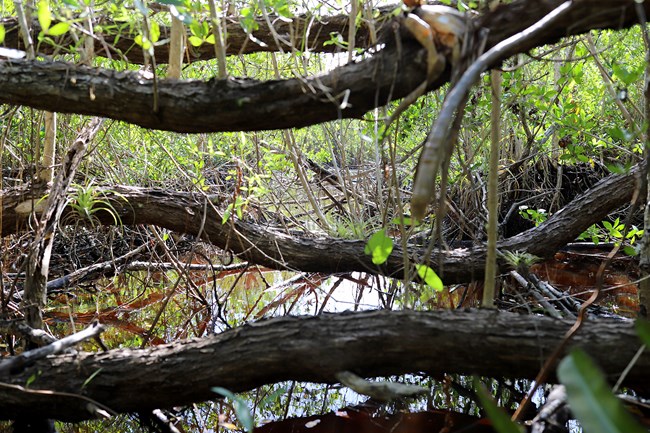
Image credit: NPS/ April Watson
An Irreplaceable Legacy
Long ago, Indigenous people of southern Florida adapted to the freshwater marsh of the Everglades. They used hardwood hammocks that rose like islands in the water as a home base for daily activities. As park archeologists excavated sites on the hammocks, it became apparent that Indigenous people had gathered, cleaned, and processed food there, and, more recently, gardened. Indigenous people also constructed a canal—the Mud Lake Canal—that connected the inland Everglades to the ocean. This allowed them to move from the Bear Lake region of the Everglades to Whitewater Bay while avoiding the treacherous waters in Cape Sable.
The Shark River Slough Archeological District today is mostly a flooded freshwater marsh, with very little inhabitable dry ground. The slough is one of two main routes of water moving through the Everglades; the other is the Taylor Slough. The archeological sites found in the Shark River Slough are black earth middens—accumulations of sediment, peat and muck, shell and bone, and cooking fat and debris. They are akin to refuse piles today. Indigenous people may have used the Shark River Slough to form smaller family camps or to procure resources.
Unlike the middens in the Shark River Slough, those in the The Ten Thousand Islands region of southwest Florida were intentionally built. This archeological district is a maze of tiny islands, mangroves, and slow-moving water, with extensive shell middens and shell works from about 1,000 to 1,500 years ago. Shell works are more intricately designed and constructed than a typical shell mound. They have some of the largest and most complex shell constructions in the world. Indigenous people used them as platforms for building homes. A 16th century account described one such home as a very tall and wide house situated on top of a mound, encircled by reed mats and with benches along its walls.

Image credit: NPS / Anthony Sleiman
Archeological sites are not the only culturally significant ones in the park; there are also many post-colonial features—features built after European colonization. Canals made in the mid to late 1800s to allow connections between Florida Bay and other parts of the Everglades are still visible today. The Homestead Canal, Cape Sable, and the Buttonwood Canal provided transportation routes as well as drainage.
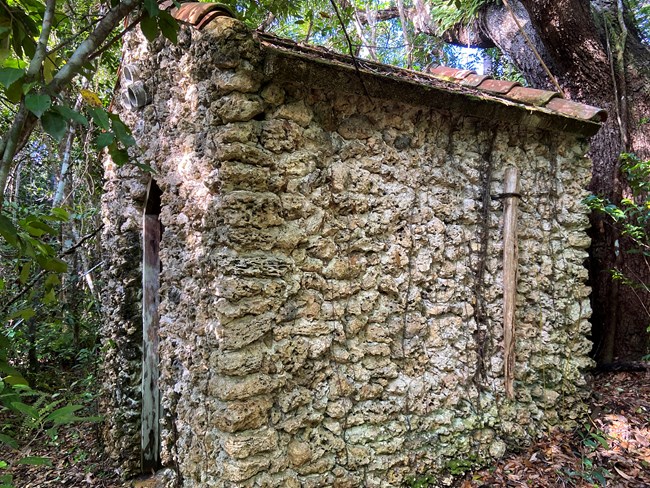
Image credit: NPS / April Watson
The park also has structures that date from the 1930s to the 1970s. During the Depression, as a part of the New Deal, President Roosevelt established the Civilian Conservation Corps, which did some work in the park. The remains of corps camps in Royal Palm and Flamingo still exist. The camp buildings in Flamingo were constructed of limestone blocks, which were durable enough to survive even when other parts of the buildings did not make it.
During the 1960s, the park built Mission 66 buildings. They were a result of the National Park Service’s efforts to modernize and address increased visitation with the growth of automobile culture after World War II. The buildings were constructed in the Modern Movement style. Examples of these buildings in Everglades are the Flamingo Visitor Center and the Shark Valley Tower.
Still Vast, but Half of What It Was
The Everglades is a one-of-a-kind, two-million-acre subtropical wetland across central and south Florida. This massive area has numerous ecosystems dominated by the flow of freshwater. Although people often assume the water in the Everglades is salty or brackish, it is actually fresh. This freshwater moves slowly around the cypress domes and hardwood hammocks that form the classic ”tree islands” of the Everglades.
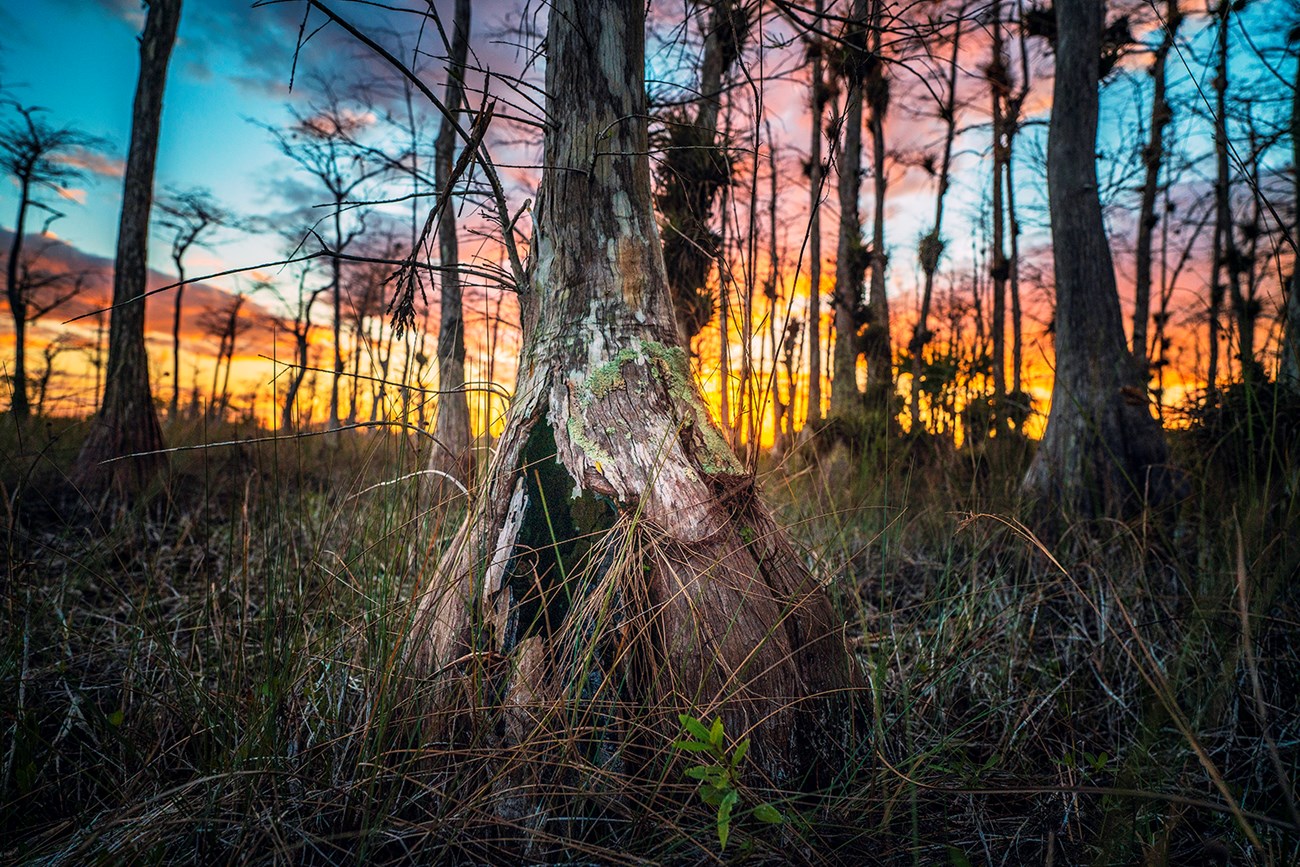
Image credit: NPS / Anthony Sleiman
Water spills over the Everglades’ marl prairie, creating solution holes—pits where aquatic animals overwinter. It seasonally floods marshes populated with sawgrass, which stores the freshwater in its roots. The freshwater finally flows out to the mangrove swamps to enter Florida Bay. In the past, the natural overflow of water from Lake Okeechobee spilled freely down and out to the south, moving slowly towards the ocean. This created shallow rivers with large expanses of sawgrass marsh—the "river of grass."
Since the 1800s, human alterations to the Everglades have halved its size. Water removal for agricultural and domestic purposes has reduced the water flowing through the Everglades. Runoff from agricultural fields and residential areas has changed the water’s chemistry. When the southern part of the Everglades became Everglades National Park in 1947, water control was a huge problem.
With up to 1.2 meters—about four feet—of sea level rise, large swaths of the park will be completely underwater during the highest tides by the year 2100.
The Comprehensive Everglades Restoration Plan, authorized in 2000 by Congress, and the Central Everglades Planning Project, which went into effect in 2011, aim to restore the historic flow of water. These projects are ongoing, and the first round of feasibility studies are underway for the Central Everglades project. But the impacts from climate change are already upon us.
An understanding of how climate change impacts are occurring could help the park predict and prepare for the future. Visualizations from NOAA’s Office of Coastal Management estimate that with up to 1.2 meters—about four feet—of sea level rise, large swaths of the park will be completely underwater during the highest tides by the year 2100. Sea level rise will swamp the Ten Thousand Islands Archeological District and the Flamingo District. All but the most centrally located cultural sites would be inundated. As grim as this sounds, it’s not the only such problem the Everglades will face.

Image credit: NPS / April Watson
Inundated on Two Fronts
Because Florida’s bedrock is porous, water can intrude into archeological sites from underneath. Scientists can predict the impact of this by looking at artifacts like bone and shell to see if they are absorbing more water or showing increased signs of degradation. We can also examine site sediment for increases in moisture from top to bottom. Models of climate change and hydrology can show how much and where water levels could change.
To get a sense of what’s coming, park staff examined USGS monitoring station data for groundwater trends. We used trend data collected since 2013 for five groundwater monitoring stations to predict future trends to the year 2040. We wanted to predict the rate of change for groundwater levels at each of the groundwater monitoring stations. The western wells are about 10 feet deep, whereas the eastern wells are about 10 to 31 feet deep. From this information, we estimated the depth of the points between the monitoring stations.
Our analysis showed that groundwater in the northwest portion of the park could increase between the years 2020 and 2040. For example, in the eastern Everglades, water levels could increase up to half an inch. That may not seem like a lot, but it's significant in an area as flat as the Everglades, where most land is at or below sea level.
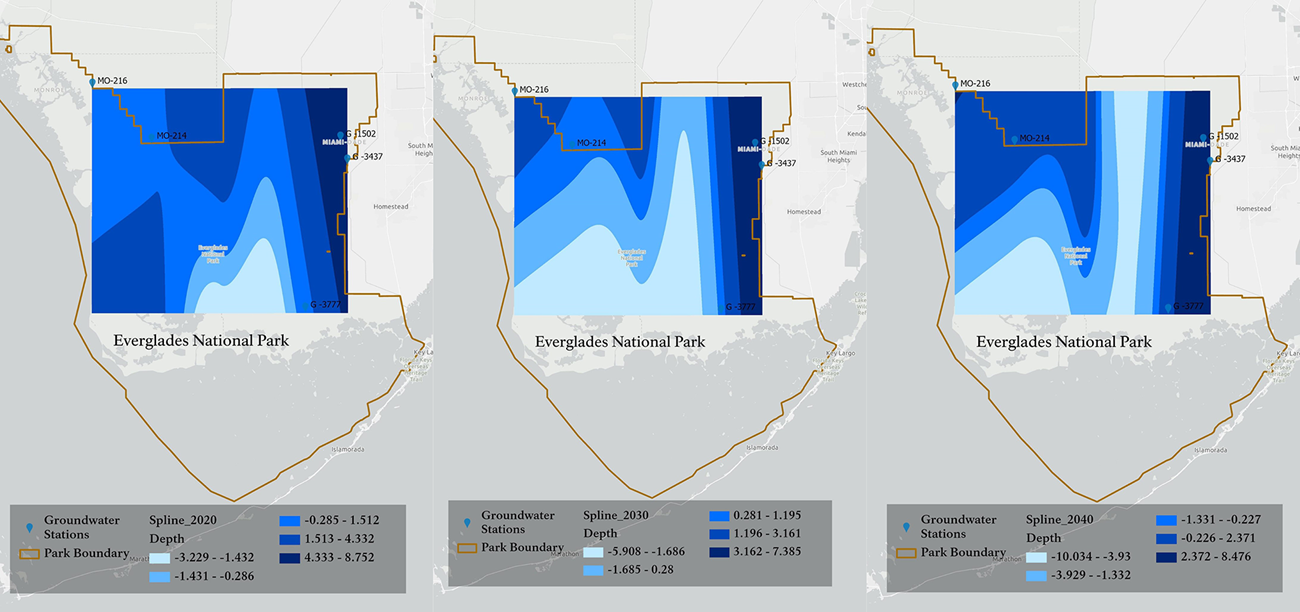
Image credit: NPS / April Watson
But areas of the park in the central and southern portions, like Shark River Slough and Flamingo, may become drier. Shark River Slough is naturally wet, so increased dry conditions could lead to erosion and wildfires in that area. Flamingo, while drier than Shark River Slough, is naturally seasonally inundated. Water level changes could mean greater degradation of its archeological materials. D.S. Monty Watson, a geologist and senior scientist who works for an environmental consulting firm hired by the National Park Service, says if groundwater is lower than sea level, ocean water will more easily flow into the lower areas of the Everglades.
"Climate change is happening, and cultural sites can’t get up and move. We need to focus on protection."
“One of the biggest problems when there is drought or overuse of water,” says Watson, is that “the groundwater table lowers. And if you are near the coast, it is much easier for sea water to move inland. And because saltwater is more buoyant than freshwater, the saltwater will be higher up.” This means that saltwater could potentially push through the porous limestone and soil into the bottom of archeological sites. As Watson says, “Climate change is happening, and cultural sites can’t get up and move. We need to focus on protection.”
A Saltier Everglades?
The predictions aren’t good news for Everglades National Park’s archeological materials and sites. Saltwater intrusion will modify the properties of the soil and the historical flow of water over and around cultural sites. Hydraulic changes people made to water flow in south Florida will compound this effect, threatening even inland sites in the central portion of the park.
There are 289 archeological sites and 111 post-colonial sites in the park. If the water reaches six feet deep, roughly half of those sites could be affected by inundation or groundwater level changes. Like southern Florida, the Arctic is on the front lines of climate change. Artic studies show that changes in water levels and soil chemistry have a profound impact on all artifact types. And coastal erosion, microbial degradation, or changes to vegetation ground cover might lead to root intrusion and ground surface subsidence.
Without the mangroves protecting them, it is likely sites would erode, and their increased visibility could lead to vandalism and more damage.
Tara Root, a hydrologist with the U.S. Geological Survey, expects saltwater intrusion to make the Everglades saltier. She says, “There are multiple routes for saltwater to come into the park—ground and sea level rise, as well as channels and [surface] lows where sea water can come in.” That water will flow over the ground and seep into the groundwater and into any buried cultural remains, such as middens and shell works. Undiscovered material and post-colonial sites that are in or near the ground surface are also at risk.
Previous studies suggest that increased saltwater intrusion might cause mangrove roots to erode and move mangroves inland. Mangroves are the ground cover vegetation for many of the coastal sites in the Everglades. Without the mangroves protecting them, it is likely sites would erode, and their increased visibility could lead to vandalism and more damage. Many archeological sites at Everglades National Park are in peat soils. Saltwater intrusion could also cause peat loss, changing the soil and water properties of the sites, eroding or drying them out.
The Archeologist's Rosetta Stone
For archeologists, the impact of water level changes on bone artifacts is one of the most pressing issues. Animal bones are an archeologist’s version of the Rosetta stone: they can tell us a lot about where and when the animals lived, how they died, and who consumed them. They could indicate past environmental changes and how humans adapted to them. A slew of archeological sites in the park are middens, composed of either shell or earth. Thousands of animal bone remains can be inside these middens. Under changing water conditions, the middens might destabilize or completely disintegrate. If the bones disintegrate, we will lose valuable information.
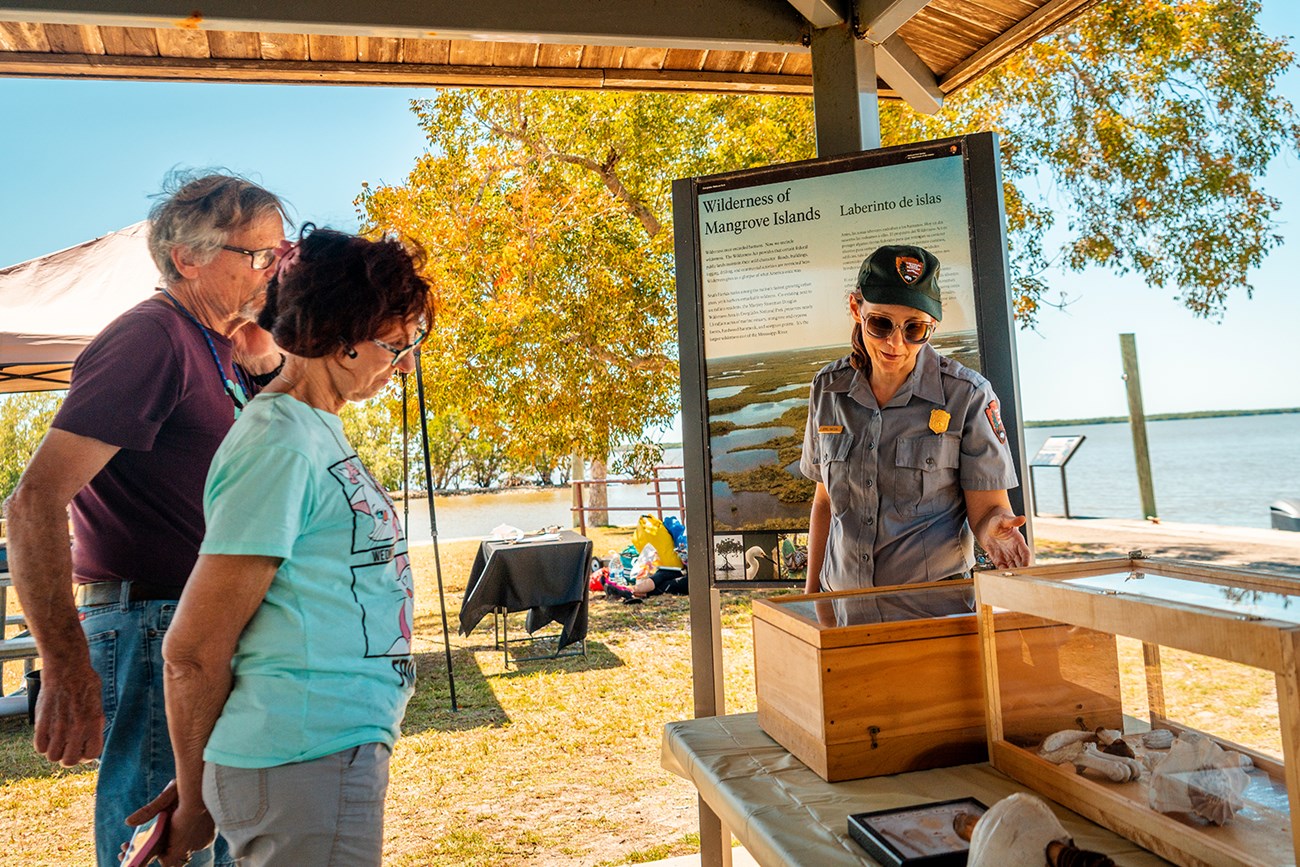
Image credit: NPS / April Watson
John Griffin, a former Everglades National Park archeologist, analyzed animal remains from three park sites. He found that most of them were from bony fish, but he also found cartilaginous fish (sharks and rays) and reptiles (mostly turtles). If the bulk of the animal remains at Everglade sites is similar to what Griffin described, what effect will increasing groundwater levels have on them?
Past work on animal bone density (e.g., salmon, turtle, and juvenile pigs) has shown that such remains are quite porous. Fish head bones, as well as reptile bones, post-cranial bony fish, and fish scales have all displayed a statistically significant difference in weight from water absorption. Porosity allows for greater volumes of water to move through the bone, so subsequent degradation is likely to be hastened in these remains.
Another concern for artifacts under fluctuating water conditions is increased acidity of the soil and surrounding water at a site. Archeological bone of any type is at greater risk in acidic sediments than modern bone, which might withstand acidic conditions better. Bone from a recently dead animal retains collagen and protein, which is lost as the bone ages. Mineral, collagen, and proteins then leech into the surrounding environment. Older bones, such as those found at archeological sites, have long since lost much of the minerals and collagen that made up the bone. The loss of collagen means that the bone cannot withstand acidic conditions as well and is more quickly dissolved.
Just as your stomach will naturally adjust its acidity or alkalinity in response to different conditions, bone often buffers its surrounding matrix by leaching minerals.
Just as your stomach will naturally adjust its acidity or alkalinity in response to different conditions, bone often buffers its surrounding matrix by leaching minerals, increasing its substrate’s alkalinity. But bone’s ability to do this decreases in very low pH (acidic) conditions and when the bone is old. In a dynamic environment, where groundwater levels are fluctuating and water is moving through archeological material, this buffered zone will continually adjust its pH levels by breaking down bone minerals. Monitoring sediment and water pH is therefore crucial for preserving bone where it is found. It is the first step to knowing whether we need to excavate or remove artifacts. Archeologists prefer in situ—in place—preservation, but if the pH of the area has changed, that may no longer be feasible.
Other Objects at Risk
The impact of changing water levels on bone is just one factor among many that archeologists face as they work to preserve sites in coastal areas around the world. Wooden objects, shell material, limestone blocks—such as in Civilian Conservation Corps buildings, and metal artifacts could also degrade. This could cause corrosion, microcracking, flaking, moisture accumulation, structural damage, and disintegration. Hydrologist Tara Root says these are the issues that the U.S. Geological Survey, the National Park Service, and the broader scientific community are grappling with.
Soil microbes consume carbon dioxide and drive decomposition, which is good for the soil. But they may also consume any organic material in the soil or water, including wooden artifacts.
Our analysis showed that groundwater levels are likely to rise in some areas and decrease in others. We expect increased dryness in the Shark River Slough. The wetland area of the Everglades is an anaerobic environment, meaning it has low levels of oxygen. With loss of water comes increased oxygen, and with increased oxygen, soil microbes—bacteria—increase.
Soil microbes consume carbon dioxide and drive decomposition, which is good for the soil. But they may also consume any organic material in the soil or water, including wooden artifacts. The sites in the Shark River Slough are generally on the higher, drier end of a tree island. Wooden artifacts, seldom found in the Florida climate, may yet be present and well preserved in the wet muck on the tree island or in the adjacent water. If the Shark River Slough area becomes drier, these artifacts could be damaged or destroyed.
Stemming the Tide
The cultural resources team at Everglades National Park monitors the effects of climate change on sites throughout the park. The team photographs and documents site change and analyzes changes from land loss, extreme weather impacts, and sea level rise. We walk over the sites, looking for damage caused by visitors, storms, or other impacts. Our unpublished work from 2011 and 2017 found that material had eroded and washed out of archeological deposits at several of these sites. With input from groups and individuals with an interest in the park, we plan to develop treatment and stabilization protocols for sites at risk and further evaluate those sites situated in the park’s interior.
Biological Resources Branch Chief Tylan Dean says the Central Everglades Planning Project intends to pump more than double the current amount of water into the Shark River Slough region. Based on current models, Dean says the area seems wetter than predicted, with a least a foot of water going into it, perhaps more. This might be good news for the inundated sites in Shark River Slough, as this would be closer to the slough’s historic water levels.
Like the last of an endangered species, once they are gone, they are gone forever, and with them the valuable lessons we could learn from our shared cultural past.
But adding more water to a drying area could bring its own problems. The Everglades ecosystem has been excessively drained, so the Shark River Slough area has been drier than normal, and the soils there have been eroding. This could cause the mounds on the tree islands to crumble into the water or could bring increased wildfires. Even though fire is a natural event in the Everglades, to which it is adapted, excessively frequent wildfires may burn and damage cultural sites.
We are also eyeing heritage monitoring programs like the one developed by the Florida Public Archeology Network as a future project for Everglades National Park. The program recruits citizen scientists to help archeologists monitor sites for potential damage. Once citizen scientists get through the training, they know what to look for, so they can take pictures and notes at nearby sites and send the information to archeologists. The archeologists then use this information to determine whether the sites are being damaged.
Protecting cultural sites in the Everglades is a work in progress, as climate change and rising sea levels have an ongoing impact. Although many of the artifacts in Everglades National Park are below ground, they are incredibly fragile. Like the last of an endangered species, once they are gone, they are gone forever, and with them the valuable lessons we could learn from our shared cultural past.

About the author
April Watson is the park archeologist for Everglades and Dry Tortugas National Parks. She is responsible for the protection and preservation of cultural resources throughout both parks. She provides geographic information systems (GIS) support and guidance to the cultural resources team. She is particularly interested in climate change effects on archeological sites, studying animal remains and shells, and Southeastern Indigenous pottery.
